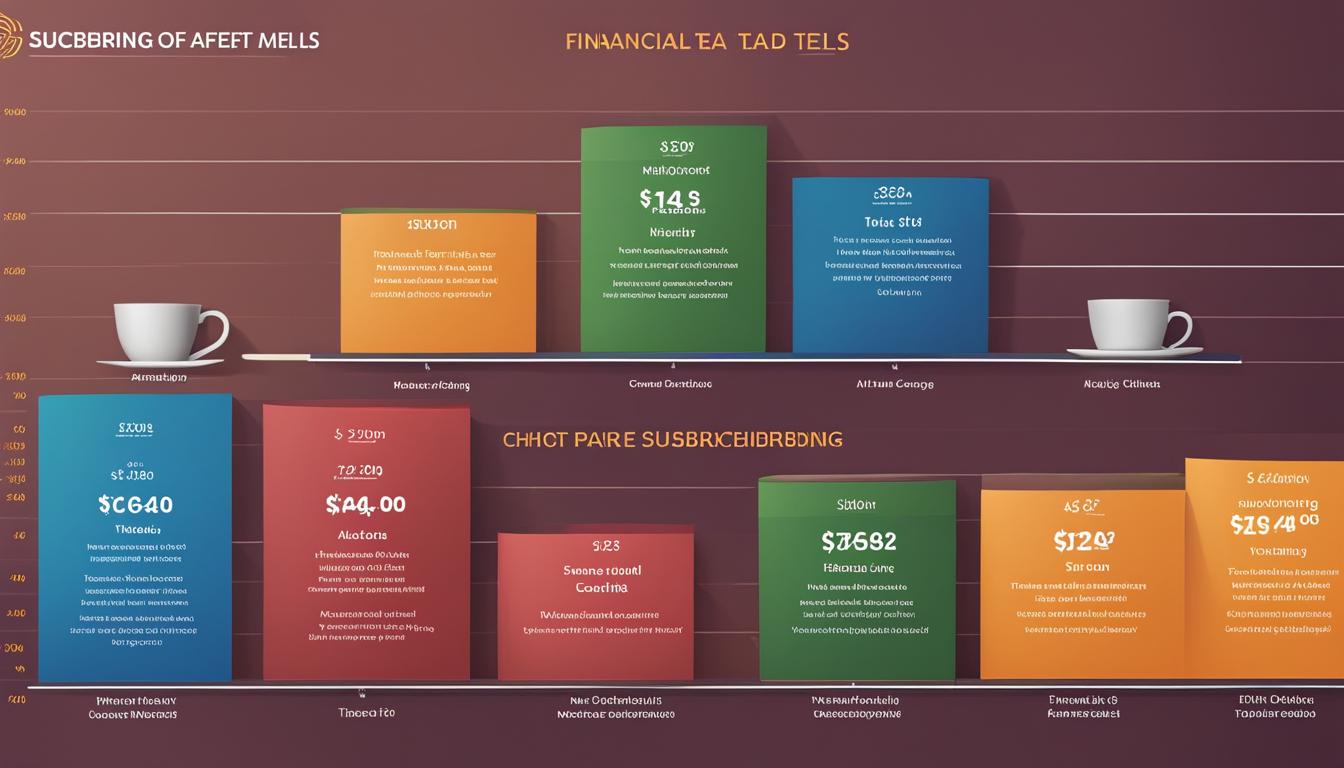The subscription marketplace has witnessed exponential growth over the past decade, with businesses embracing the subscription model as a means of generating consistent revenue. In this article, we delve into the economic impact of tea subscription models, exploring the benefits they offer both tea brands and consumers. We’ll also analyze the pricing strategies employed by tea subscriptions and examine the financial sustainability of this emerging industry.
Key Takeaways:
- Tea subscription businesses are experiencing rapid growth in an otherwise challenging economic climate.
- Tea subscriptions provide recurring revenues for brands and curated tea experiences for consumers.
- Successful tea subscription businesses focus on building customer relationships and offering high-quality teas.
- Pricing strategies in the tea subscription market play a crucial role in achieving financial sustainability.
- Investing in market analysis and evaluating the cost-benefit ratio is essential for long-term success.
Benefits of Tea Subscriptions for Tea Businesses and Consumers
Tea subscriptions offer a win-win model for both tea businesses and consumers. For tea brands, subscriptions provide recurring revenues, brand loyalty, and customer relationships. As the tea subscription market continues to grow, it presents an opportunity for businesses to expand their reach and drive revenue growth. By offering curated tea experiences and a variety of tea options, tea brands can attract and retain customers, fostering brand loyalty and repeat purchases.
Consumers also benefit from tea subscriptions by gaining access to a broader range of tea products and curated experiences. Through tea subscriptions, they can discover new teas, experience different flavors, and connect with local tea producers. The convenience of having tea delivered directly to their doorstep further enhances the overall experience. With each subscription box, consumers can anticipate the delight of trying new and unique teas, creating excitement and enhancing their tea-drinking journey.
Successful tea subscription businesses focus on delivering high-quality teas and building a sense of community and connection with their customers. By sourcing authentic and premium teas, these businesses establish themselves as trusted providers of exceptional tea products. They engage with their subscribers through personalized experiences, educational content, and interactive platforms, creating a strong sense of community and fostering connections among tea enthusiasts. This customer-centric approach not only enhances the overall tea subscription experience but also drives customer satisfaction and long-term loyalty.
Table: Tea Subscription Market Revenue Trends
| Year | Total Revenue (USD) | Growth Rate |
|---|---|---|
| 2017 | $100 million | 15% |
| 2018 | $150 million | 25% |
| 2019 | $200 million | 20% |
| 2020 | $250 million | 25% |
As shown in the table above, the tea subscription market has experienced consistent revenue growth over the past few years. From 2017 to 2020, the total revenue of the market has steadily increased, with an average annual growth rate of 21.25%. This trend indicates the growing popularity and profitability of tea subscription services. With the continuous expansion of the market and increasing consumer demand for unique tea experiences, tea businesses have the opportunity to capitalize on this growing trend and establish themselves as leaders in the tea subscription industry.
Overall, tea subscriptions provide tangible benefits for both tea businesses and consumers. By offering recurring revenues, brand loyalty, and curated experiences, tea brands can thrive in the competitive market while providing consumers with a diverse range of high-quality teas and a sense of community. As the tea subscription market continues to flourish, it presents exciting opportunities for tea businesses to grow and innovate while satisfying the evolving preferences and demands of tea enthusiasts.

Key Factors for Successful Tea Subscription Businesses
When it comes to building successful tea subscription businesses, there are several key factors to consider. In this section, we will explore the economic forecast for the tea subscription market, analyze the investment opportunities, and evaluate the cost-benefit ratio for tea subscriptions.
Understanding the Economic Forecast
Before diving into the tea subscription market, it’s crucial to analyze the economic forecast. This helps tea businesses make informed decisions and plan for long-term success. By studying industry trends, market demand, and consumer behavior, businesses can anticipate challenges and capitalize on opportunities. For example, understanding the projected growth rate of the tea subscription market can guide businesses in making strategic investments and setting realistic goals.
Conducting Investment Analysis
Investing in a tea subscription business requires careful analysis of potential risks and returns. Conducting an investment analysis helps tea businesses assess the financial viability of their subscription models. This analysis should consider factors such as initial investment costs, operational expenses, customer acquisition costs, and projected revenue streams. By evaluating these aspects, businesses can determine the profitability and sustainability of their tea subscription ventures.
Evaluating the Cost-Benefit Ratio
While tea subscriptions offer opportunities for recurring revenues, it’s essential to evaluate the cost-benefit ratio. This entails weighing the costs associated with running a subscription service against the potential benefits. Costs may include sourcing high-quality teas, packaging, shipping, marketing, and customer support. Benefits range from increased brand loyalty, customer retention, and the potential for upselling other tea products. By conducting a comprehensive cost-benefit analysis, tea subscription businesses can make data-driven decisions and optimize their operations.

Conclusion
Tea subscription models have revolutionized the subscription marketplace, surpassing traditional sales growth and offering a world of benefits for both tea businesses and avid tea lovers. These models have become a gateway to recurring revenues, curated tea experiences, and thriving customer relationships.
Successful tea subscription businesses understand the importance of delivering high-quality teas that captivate the senses and connect with customers on a deeper level. By offering a wide variety of tea options and personalized experiences, they cater to the diverse preferences of tea enthusiasts.
Financial sustainability and investment analysis are vital for the long-term success of tea subscription businesses. By carefully assessing the tea subscription market and staying attuned to market trends and consumer demands, businesses can make informed decisions that lead to profitability and growth.
In a rapidly evolving tea industry, the journey to success is paved with adaptability and customer-centric strategies. By prioritizing economic factors, embracing market trends, and nurturing customer relationships, tea subscription businesses can flourish and carve a place for themselves in the highly competitive tea market.
FAQ
What is a tea subscription?
A tea subscription is a service that allows customers to receive a curated selection of teas on a recurring basis. It provides an opportunity to try new and unique teas, discover different flavors, and connect with local tea producers.
How do tea subscriptions benefit tea businesses?
Tea subscriptions offer recurring revenues, brand loyalty, and customer relationships for tea businesses. They provide a platform for growth, reaching wider audiences, and driving customer engagement. It allows tea brands to showcase a wide variety of tea options and personalized experiences.
What are the benefits of tea subscriptions for consumers?
Tea subscriptions give consumers access to a broader range of tea products and curated tea experiences. They can discover new teas, experience different flavors, and connect with local tea producers. It offers convenience and the opportunity to explore the world of tea without the hassle of searching for new teas themselves.
How can tea subscription businesses succeed?
Successful tea subscription businesses focus on delivering high-quality, authentic teas and building a sense of community and connection with their customers. They adapt to market trends, offer personalized experiences, and analyze the economic forecast to make informed decisions. Financial sustainability and investment analysis are crucial for long-term success.
How can tea subscription businesses keep costs low?
Tea subscription businesses can keep costs low by efficient supply chain management, securing volume discounts, and taking advantage of economies of scale. Optimizing profit margins is essential for the financial sustainability of the business.





